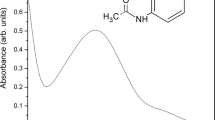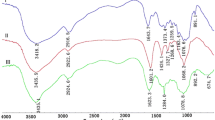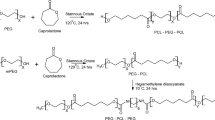Abstract
Poly(N-isopropylacrylamide-co-acrylic acid) hydrogel was grafted onto track-etched polycarbonate (PC) films using the free-radical polymerization method to prepare thermo-sensitive micro-porous films. Differential scanning calorimeter analysis was used to determine the lower critical solution temperature for the hydrogels. Thermo-gravimetric analysis was used to determine the thermal stability of the PC–hydrogel composite films. The composite films were characterized using Fourier transform-infrared spectra, scanning electron microscope, and effective pore diameters derived from water permeability data. 4-Acetamidophenol, citric acid, KCl, and methyl orange were used as the model drugs. For neutral drugs, the larger molecules exhibited lower permeability but higher on–off ratio than smaller ones. The strong electrolyte model molecules (KCl) exhibited depressed permeability due to enlarged hydrated ion sizes. The acidic (citric acid) model solution promoted gel shrinkage, resulting in increased drug permeability and on–off ratio.










Similar content being viewed by others
References
Wandera D, Wickramasinghe SR, Husson SM (2010) Stimuli-responsive membranes. J Membr Sci 357:6–35
Malonne H, Eeckman F, Fontaine D, Otto A, De Vos L, Moës A, Fontaine J, Amighi K (2005) Preparation of poly(N-isopropylacrylamide) copolymers and preliminary assessment of their acute and sub-acute toxicity in mice. Eur J Pharm Biopharm 61:188–194
Lue SJ, Chen CH, Shih CM (2011) Tuning of lower critical solution temperature (LCST) of poly(Nisopropylacrylamide-co-acrylic acid) hydrogels. J Macromol Sci B 50:563–579
Lue SJ, Chen CH, Shih CM, Tsai MC, Kuo CY, Lai JY (2011) Grafting of poly(N-isopropylacrylamide-co-acrylic acid) on micro-porous polycarbonate films: regulating lower critical solution temperatures for drug controlled release. J Membr Sci 379:330–340
Fu G, Soboyejo WO (2010) Swelling and diffusion characteristics of modified poly (N-isopropylacrylamide) hydrogels. Mater Sci Eng, C 30:8–13
Evingür GA, Pekcan O (2012) Effect of LCST on the swelling of PAAm-NIPA copolymers: a fluorescence study. Polym Bull 68(1):223–238
Yun J, Kim HI (2012) Dual-responsive release behavior of pH-sensitive PVA/PAAc hydrogels containing temperature-sensitive PVA/PNIPAAm microcapsules. Polym Bull 68(4):1109–1119
Yang B, Yang W (2003) Thermo-sensitive switching membranes regulated by pore-covering polymer brushes. J Membr Sci 218:247–255
Spohr R, Reber N, Wolf A, Alder GM, Ang V, Bashford CL, Pasternak CA, Hideki O, Yoshida M (1998) Thermal control of drug release by a responsive ion track membrane observed by radio tracer flow dialysis. J Control Release 50:1–11
Ramírez-Fuentes YS, Bucio E, Burillo G (2008) Thermo and ph sensitive copolymer based on acrylic acid and N-isopropylacrylamide grafted onto polypropylene. Polym Bull 60:79–87
Ikram S, Kumari M, Gupta B (2011) Thermo sensitive membranes by radiation-induced graft polymerization of N-isopropyl acrylamide/acrylic acid on polypropylene nonwoven fabric. Radiat Phys Chem 80:50–56
Meléndez-Ortiz HI, Bucio E (2008) Radiation synthesis of a thermo-pH responsive binary graft copolymer (PP-g-DMAEMA)-g-NIPAAm by a two step method. Polym Bull 61(5):619–629
Lue SJ, Hsu JJ, Wei TC (2008) Drug permeation modeling through the thermo-sensitive membranes of poly(N-isopropylacrylamide) brushes grafted onto micro-porous films. J Membr Sci 321:146–154
Kuroki H, Ohashi H, Ito T, Tamaki T, Yamaguchi T (2010) Isolation and analysis of a grafted polymer onto a straight cylindrical pore in a thermal-responsive gating membrane and elucidation of its permeation behavior. J Membr Sci 352:22–31
Wang W, Tian X, Feng Y, Cao B, Yang W, Zhang L (2010) Thermally on-off switching membranes prepared by pore-filling poly(N-isopropylacrylamide) hydrogels. Ind Eng Chem Res 49:1684–1690
Lue SJ, Hsu JJ, Chen CH, Chen BC (2007) Thermally on-off switching membranes of poly(N-isopropylacrylamide) immobilized in track-etched polycarbonate films. J Membr Sci 301:142–150
Wan LS, Yang YF, Tian J, Hu MX, Xu ZK (2009) Construction of comb-like poly(N-isopropylacrylamide) layers on micro-porous polypropylene membrane by surface-initiated atom transfer radical polymerization. J Membr Sci 327:174–181
Pan K, Zhang X, Ren R, Cao B (2010) Double stimuli-responsive membranes grafted with block copolymer by ATRP method. J Membr Sci 356:133–137
Chou FY, Shih CM, Tsai MC, Chiu WY, Lue SJ (2012) Functional acrylic acid as stabilizer for synthesis of smart hydrogel particles containing a magnetic Fe3O4 core. Polymer 53:2839–2846
Chou FY, Lai JY, Shih CM, Lue SJ, In vitro biocompatibility of magnetic thermo-responsive nano-hydrogel particles of poly(N-isopropylacrylamide-co-acrylic acid) with Fe3O4 cores: effect of particle size and chemical composition. Colloids Surf B (in revision)
Acknowledgments
We thank the National Science Council of Taiwan for financial support (NSC 100-2815-C- 182-001-E).
Author information
Authors and Affiliations
Corresponding author
Rights and permissions
About this article
Cite this article
Tsai, MC., Shih, CM. & Lue, S.J. Drug permeation behavior through thermo- and pH-responsive polycarbonate-g-poly(N-isopropylacrylamide-co-acrylic acid) composites. Polym. Bull. 70, 1003–1017 (2013). https://doi.org/10.1007/s00289-012-0865-0
Received:
Revised:
Accepted:
Published:
Issue Date:
DOI: https://doi.org/10.1007/s00289-012-0865-0




